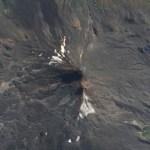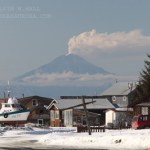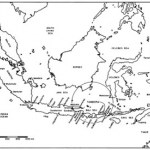
Well, after lamenting the slow volcano news, things are beginning to pick up again. Beyond the news of a potential increase in activity at Anak Krakatau, there are a few other newsworthy bits that have come up:
Mt. Kerinci in Indonesia
Mt. Kerinci in Indonesia is showing signs of eruption. The volcano is the highest mountain on the island of Sumatra, reaching 3,800 m / 12,400 feet and last erupted in March 2008. Its volcanic activity is marked by small (VEI 2) explosions of ash and tephra. Currently, the volcano is experiencing increased tremors and minor explosions that rained ash on a tea…
Anak Krakatau erupting in 2007.
There is a report out tonight that activity might be increasing at Anak Krakatau in Indonesia, however, it is unclear whether it is actually increasing or not. People are evacuating the coastal area of the Sunda Strait to Bandarlampung in fear that a major eruption of the volcano is on the horizon. However, the Volcanology and Geological Disaster Mitigation Center (PVMBG) in Indonesia has not changed the alert status at Anak Krakatau and it remains at 2 of 4 (~Orange Status). The volcano has been erupting almost constantly for the last few years, producing…
As of late, a number of comments have been eaten by the SB spam filters. Mostly, they are longer comments with hyperlinks. I try to check the spam folder to catch such incorrectly identified comments, but if you notice your comment not showing up in the discussion, shoot me an email and I can check the folder. I don't want to lessen the spam filter effectively so we don't get inundated with fantastic offers for various products, so hopefully this won't become too much of a problem.
Thanks for all the comments! Keep them coming!
It has been rather quiet on the volcano-front in the last week. Redoubt and Llaima (in spanish), after a few weeks of intense eruption, are both back on Orange Alert. News of the eruptions from Hunga Tonga Hunga Ha'apai and Fernandina is rather sparse in the details. The news of volcanism in 2009 seems to have settled down.
A few tidbits I caught over the weekend:
Chaiten
Damage wrought by the eruption of Chaiten on the town of Chaiten in Chile, taken in early December 2008. Image courtesy of the NASA Earth Observatory.
Don't you feel like you're read this sort of story before after other…
The weekend is rolling in and I might end up spending most of it in the 90+ degree California weather, so unless something big comes up (volcanically), I'll leave you with a few news bits.
Llaima
Llaima in April 2009. Image courtesy of the NASA Earth Observatory
This is a true color image of Llaima in Chile, provided by the great folks at the NASA Earth Observatory. You can clearly see the dark grey new tephra on the main summit cone along with the grey ash covering the snow on the southwestern part of the volcano (north is up). A few other fun features are some smaller parasitic cones in…
Redoubt with a prominent steam plume on April 7,2009. Image courtesy of Robert Cole/AVO
Eruptions reader Brian just pointed out that AVO has posted a new webcam (well, a redirectly webcam) for the volcano and I thought it deserved its own post. This new angle gets you right up to the new dome forming on the volcano. The Hut webcam is now zoomed into the area where new magma is extruding - mostly passively - from this eruption. From this vantage point, when conditions permit - you might be able to get a good view of the dome-collapse block & ash flows that typically accompany silicic dome…
Fissure vent eruption from Fernandina in the Galapagos Islands.
In news that comes as a surprise to no one, the current eruption on Fernandina in the Galapagos is having some adverse effect on the wildlife in the Pacific archipelago. Numerous dead fish and sea lions have been seen in the ocean near the actively erupting volcano - now, what exactly is causing the deaths is more speculative. I would imagine with the large plume being produced by the volcano, along with the lava flows reaching the ocean, that volcanic gases and the lava's interaction with the sea water might be the leading…
Mount Pagan in the Mariana Islands erupting on April 15, 2009. Image courtesy of the NASA Earth Observatory.
Up until fairly recently, a lot of volcanoes got away with erupting without anyone knowing the better. However, with all the "eyes in the sky" we have these days, even remote oceanic volcanoes get caught in the act of erupting. Case in point is this image (above) of Mt. Pagan in the Mariana Islands erupting. It was captured by the MODIS satellite yesterday and it shows a health ash plume emanating from the volcano. Pagan is an oceanic stratovolcano on the sparsely populated island of…
Here's the latest Global Volcanism Program activity report for worldwide volcanism. Some of the highlights (beyond Fernandina and Llaima) include:
Vulcanian-style eruptions at Sakurajima, Japan. And guess what? There is a Sukarajima webcam! {Hat tip to Eruptions reader Jodie Morris for this link}.
Strombolian-style explosions and avalanches associated with lava flows at Arenal, Costa Rica.
A 10,000 foot / 3,000 meter ash plume from Dukono in Indonesia.
Satellite imagery exposed a thermal anomaly in the dome at Shiveluch on the Kamchatka Peninsula.
Busy day so I probably won't get to update much as we're busy hosting Dr. Charlie Bacon, geologist for the USGS, here at UC Davis today. Dr. Bacon has written some seminal papers in his career and is probably the foremost authority of the evolution of Crater Lake/Mt. Mazama (speaking of which, >a new geologic map for the Park was recently released) and the caldera-forming eruption. He's also a really nice guy.
If you want to read some of his papers, you might try these:
Bacon, C.R., Implications of silicic vent patterns for the presence of large crustal magma chambers, in: D.P. Hill, R.A…
Just a quick note before I'm off to this ...
Llaima
The SERNAGEOMIN is evaluating whether the alert level at Llaima should be lowered to Yellow in the near future (in spanish). Seismic acitivity at the volcano have come down since the eruptions started a few weeks ago and most of the activity now seems to be fumarolic in nature.
Popocatépetl
Popo (as it is also called) continues to produce steam/gas plumes (in spanish), 5 in one day on Monday of this week. However, all the other usual volcanic monitoring parameters (seismicity and the like) are unchanged according to Cenapred (National…
Redoubt from Ninilchik, AK. Image courtesy of Calvin Hall.
It has been a few days since we've talked about Redoubt. Well, it might be because the volcano has settled down for the past week, to the point that AVO put the volcano back to Orange/Watch status last week and hasn't had to go back to Red/Warning since. This is not to say the Redoubt is quiet, on the contrary, there is still elevated seismicity, an almost-constant steam/ash plume up to 15,000 feet / 5,000 meters and most importantly, the new dome (below) is still growing near the summit. The system has been actively degassing carbon…
Fernandina, Ecuador
Fernandina erupting in 2009.
UPDATE 4/13/09 at 12PM: The NASA Earth Observatory has posted a nice MODIS image showing the plume from the Fernandina eruption drifting out over the Pacific.
We have a few more details on the ongoing eruption at Fernandina in the Galapagos Islands. Officials from the Parque Nacional Galápagos (PNG) flew over the island (in spanish) and saw the eruption is coming from a several-kilometer-long fissure vent that flows towards the sea, dividing into multiple flows and then coalescing when it reaches the sea. There is also a lot of vapor being…
Chaiten erupting on January 19, 2009. Image courtesy of the NASA Earth Observatory.
It is hard to believe that we are less than one month away from one-year anniversary of the beginning of the eruption at Chaiten (and with it, the one-year anniversary of this blog!) The volcano in southern Chile is still erupting away, creating at least 2 dome complexes within the older caldera. These domes have been experiencing periodic collapses, creating block & ash flows, some of which have made it out of the caldera and down close to the ghost town of Chaiten. Along with the block & ash flows,…
Fernandina volcano in the Galapagos.
Fernandina in the Galapagos has entered a new eruptive phase according to the Geophysical Institute (GI) at the National University of Ecuador (in spanish). Satellite images show a new crater and ash column from the volcano and the GI will look for evidence of new lava flows beyond the "hot points" spotted on the satellite images.
UPDATE 4/11/09 9PM: I thought I'd add a link to the story in English now that I found one. There are also some pictures of the lava flows from La Cumbre (There is some confusion about name - Fernandina and La Cumbre are the…
Active US volcanoes and volcano observatories
After all the well-publicized words of "a certain governor in the lower forty-eight" (as Sen. Begich (D-AK) likes to call him) the "wasteful" spending on volcano monitoring improvements in the U.S. have become reality. Sec. of the Interior Ken Salazar announced $15.2 million dollars to modern the infrastructure of the nation's volcano monitoring networks (that is out of the ~$3 billion that went to the Interior - making volcano monitoring a whopping 0.5% of the stimulus that went to that department). Much of this money will likely go to one of…
Llaima in Chile, taken on April 9, 2009. Image courtesy of the NASA Earth Observatory.
The NASA Earth Observatory (currently celebrating its 10th year) has posted a number of great images of the current eruption of Llaima in Chile, taken from Earth Observing-1 and Terra Satellites. They show both the ash plume of the eruption and the lava flows associated with it (above). The image here is a false-color image of Llaima, where the bright red/orange is the lava flow from the volcano, along with the dark brown of the ash/rocks from this and previous eruptions.
The eruption itself might continue…
Tambora, Indonesia
There are big eruptions, then there are big eruptions. On April 10, 1815, Tambora, a volcano in Indonesia, produced one of the largest eruptions in human history. This eruption produced what became known as the "year without a summer" after the volcanic aerosols from the eruption produced some of the coldest summers in many parts of the world. The Tambora eruption in 1815 was a VEI 7, on a scale that goes to, well, 7*, putting it in a class of some of the largest and most violent eruptions imaginable - and I, for one, can hardly imagine what might happen if an eruption of…
Your weekly dose of volcanic activity. As a sidenote, you can now get placemarks for the weekly activity report via Google Earth. Select "Google Earth Placemarks" from the SI / USGS Weekly Volcanic Activity Report page.
Highlights of this week's report:
New explosions at Ebeko. See my article today for more details.
More evidence of increased activity at Nyamuragira and Nyiragongo, Congo. One interesting note is that scientists from the Goma Volcano Observatory noted that earthquake swarms usually precede eruption by 3-5 months.
I've seen very little news about this, but Pacaya in Guatemala…
Llaima in Chile erupting in 2009.
A quick note to pass along about the ongoing eruption at Llaima in Chile. The eruption did seem to be waning earlier in the week, but the news now is that debris from the eruption is partially blocking the vent. The cone of pyroclastic material (tephra) that has been ejected during the eruption is now overlapping the main crater, potentially blocking part of the vent ... and most people know what happens if you plug up a volcano that is actively erupting - blammo!
The SERNAGEOMIN is not certain that this cone of material (in spanish) will cause a more…



